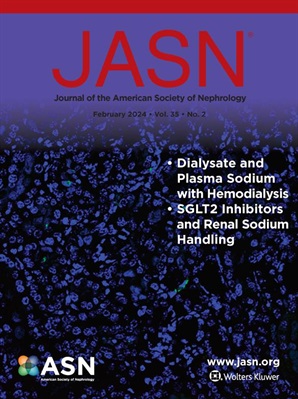Effect of Peer Mentorship on Hospitalizations among Patients Receiving Maintenance Hemodialysis: A Pragmatic Randomized Controlled Trial.
IF 10.3
1区 医学
Q1 UROLOGY & NEPHROLOGY
引用次数: 0
Abstract
BACKGROUND Patients receiving maintenance hemodialysis are hospitalized frequently, leading to disproportionate cost of care, and contributing to high morbidity and mortality. METHODS To test the effectiveness of peer mentorship to reduce hospitalization rates among patients receiving hemodialysis we performed a multi-center, pragmatic, randomized, controlled trial. Two hundred patient participants receiving hemodialysis at high risk for hospitalization were enrolled, 140 in Bronx, NY and 60 in Nashville, TN. Of these, 101 were randomized to the peer-mentor intervention and 99 were randomized to usual care. The intervention consisted of trained mentors, patients receiving hemodialysis, placing weekly telephone calls to their assigned patient participant mentees over a 3-month period. During telephone calls, mentors listened, provided emotional and informational support, and promoted self-management. During the intervention period and up to 15 months later, patient participants were observed for incidence of the primary outcome: monthly counts of unplanned hospitalizations and emergency department (ED) visits. RESULTS The mean age of all patient participants was 54 (SD 13) years, 100 (50%) were female, 110 (57%) were Black and 70 (39%) were Hispanic. The adjusted incidence rate ratio (aIRR) of primary outcome was not different between intervention vs. usual care in intention to treat analysis (aIRR 0.85; 95% CI 0.64,1.15). Pre-specified as treated analyses, with as treated defined by >20 minutes of telephone contact between mentor/mentee pairs, suggested effectiveness of peer mentoring (aIRR 0.60; 95% CI 0.47,0.76), and exploratory post-hoc analyses demonstrated differences in effectiveness by site and self-identified race of mentees. CONCLUSIONS Peer mentorship did not significantly reduce the rate of hospitalization or ED visits overall, but there may have been effectiveness among the following subgroups: those enrolled in Bronx, NY and those who self-identified as Black.同伴指导对维持性血液透析患者住院治疗的影响:一项实用的随机对照试验。
背景:接受维持性血液透析的患者经常住院,导致不成比例的护理费用,并导致高发病率和死亡率。方法为了检验同伴指导对降低血液透析患者住院率的有效性,我们进行了一项多中心、实用、随机、对照试验。200名接受血液透析的高危住院患者被纳入研究,其中140人来自纽约州布朗克斯,60人来自田纳西州纳什维尔。其中101人被随机分配到同伴指导干预组,99人被随机分配到常规护理组。干预包括训练有素的导师,接受血液透析的患者,在3个月的时间里每周给他们指定的患者参与者指导者打电话。在电话中,导师倾听,提供情感和信息支持,并促进自我管理。在干预期间和长达15个月后,观察患者参与者的主要结局的发生率:每月计划外住院和急诊(ED)就诊的计数。结果所有患者的平均年龄为54岁(SD 13),女性100人(50%),黑人110人(57%),西班牙裔70人(39%)。在意向治疗分析中,干预与常规护理的主要结局调整发生率比(aIRR)无差异(aIRR 0.85;95% ci 0.64,1.15)。预先指定的被处理分析,以导师/学员对之间20分钟的电话联系来定义被处理分析,建议同伴指导的有效性(aIRR 0.60;95% CI 0.47,0.76),探索性事后分析表明,不同地点和自认种族的学员在有效性上存在差异。结论:speer指导总体上没有显著降低住院率或急诊科就诊率,但在以下亚组中可能有效果:纽约州布朗克斯的学生和自认为是黑人的学生。
本文章由计算机程序翻译,如有差异,请以英文原文为准。
求助全文
约1分钟内获得全文
求助全文
来源期刊
CiteScore
22.40
自引率
2.90%
发文量
492
审稿时长
3-8 weeks
期刊介绍:
The Journal of the American Society of Nephrology (JASN) stands as the preeminent kidney journal globally, offering an exceptional synthesis of cutting-edge basic research, clinical epidemiology, meta-analysis, and relevant editorial content. Representing a comprehensive resource, JASN encompasses clinical research, editorials distilling key findings, perspectives, and timely reviews.
Editorials are skillfully crafted to elucidate the essential insights of the parent article, while JASN actively encourages the submission of Letters to the Editor discussing recently published articles. The reviews featured in JASN are consistently erudite and comprehensive, providing thorough coverage of respective fields. Since its inception in July 1990, JASN has been a monthly publication.
JASN publishes original research reports and editorial content across a spectrum of basic and clinical science relevant to the broad discipline of nephrology. Topics covered include renal cell biology, developmental biology of the kidney, genetics of kidney disease, cell and transport physiology, hemodynamics and vascular regulation, mechanisms of blood pressure regulation, renal immunology, kidney pathology, pathophysiology of kidney diseases, nephrolithiasis, clinical nephrology (including dialysis and transplantation), and hypertension. Furthermore, articles addressing healthcare policy and care delivery issues relevant to nephrology are warmly welcomed.

 求助内容:
求助内容: 应助结果提醒方式:
应助结果提醒方式:


